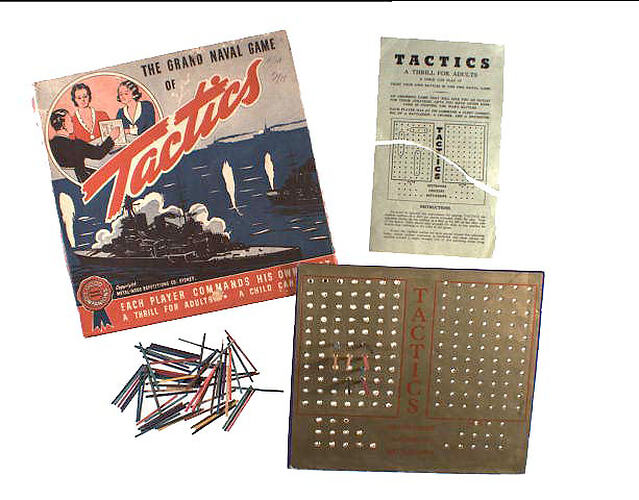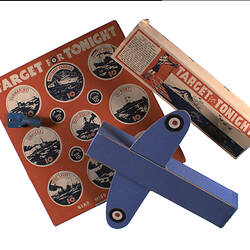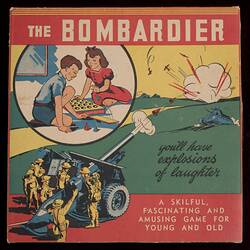Summary
Board game 'Tactics, The Grand Naval Game', made by Metal-Wood Repetitions Co. circa 1930s. In box featuring an ocean scene with battleships and group of adults playing game. The box contains a board pierced with holes, 394 coloured matchstick-type pieces of wood and an instruction sheet.
The game is optimistically described as 'a thrill for adults' - 'each player commands his own fleet'. The game is also suggested for children.
The donor's father found the game in a wardrobe of an old house in Fairfield, together with other war-related games dated to around World War II.
The Tactics game was advertised for sale in The Argus, 28 October 1944, p.10. It was available through Robertson & Mullens Ltd, 107-113 Elizabeth Street at a cost of 5/6. The advertisement stated that it could be played 'by any number of people'.
Physical Description
Square cardboard lid to box containing board game. Covered in printed paper. Top features an ocean scene with pale blue sky dark blue ocean and a battleship front centre. Smaller ships also feature. A circle top left shows two women at a table facing a man playing the game. Red lettering runs diagonally across front. Red strip along bottom and red seal at bottom left. Sides are red, white and blue with writing in white. Bottom of box is cardboard covered in royal blue and light blue paper. Included inside the box are: an instruction sheet; board; and 394 coloured matchstick type pieces of wood.
Significance
World War II changed life for everyone - including children. While fathers were away fighting 'Mr Hitler', many mothers worked long hours in offices and factories. Food and clothing were rationed, and children helped grow vegetables in backyard 'victory gardens'. After Japan entered the war in 1942 and invasion threatened, the fear of bombing hung in the air. Some city children were evacuated to rural areas. Many families built air-raid shelters in suburban backyards. Trenches were dug across school playgrounds, and air-raid drills were held. Yet wartime could be exciting, too. Military marches through the city streets, fireside games of strategy and battleships, and heroic tales of soldiers in far-off lands - all lit the imagination of many a Melbourne child. But reality hit hard for those children whose loved ones did not come home. (Melbourne Story exhibition label, 2008)
More Information
-
Collecting Areas
-
Acquisition Information
Donation from Kerry Smith, 05 Feb 1991
-
Manufacturer
Metal Wood Repetitions Co., Sydney, Greater Sydney, New South Wales, Australia, 1930-1939
Approximate date(s) - based on the hair styles and clothing of the people depicted on the front of the game box. -
Place Used
-
Inscriptions
Printed: THE GRAND NAVAL GAME/OF/ Tactics/ Copyright/METAL-WOOD REPETITIONS CO. SYDNEY./EACH PLAYER COMMANDS HIS OWN FLEET/A THRILL FOR ADULTS. A CHILD CAN PLAY IT/ GOOD COMPANIONS/GAMES SERIES.
-
Classification
-
Category
-
Discipline
-
Type of item
-
Overall Dimensions
23.8 cm (Width), 2.7 cm (Depth), 23.5 cm (Height)
-
Dimensions
238 mm (Length), 27 mm (Width), 235 mm (Height)
Measurement From Conservation.
-
Keywords
Home Fronts, Pastimes, Recreation, Wars & Conflicts, World War II, 1939-1945


